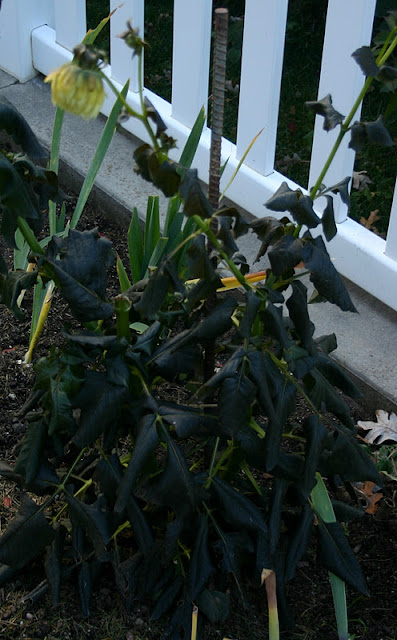When the first killing frost happens, you'll immediately know--for one thing, the foliage on the dahlias will be black. Last night we had our first killing frost of the season. After this happens, cut the stalks of your dahlias back to about 6 inches and carefully dig the roots with a pitch fork--their tubers can be attached with just a small, very delicate fiber, so special care must be given as to not break them off. Gently shake off the soil, and then turn your clump upside down to dry for a few hours--I usually just put mine in the garage or the patio. I always tag my clumps with their name, and a piece of string or yarn tied around the short stem with its color. Then move your clumps indoors and store them for another week, ensuring they are dry for storage. (Some people even rinse their tubers off, or use a small paint brush to get all the soil in the crevices before they pack them up for the winter months--if you rinse them off, make sure they are completely dry before storing). For over-winter storage, dahlias require a well-ventilated, relatively dry spot where temperatures remain between 36 and 45 degrees. If your tubers get much humidity, they will get moldy and rot. I've tried several storage techniques--and, to be honest, haven't found one for me that has been 100% successful. A root cellar is ideal, and two friends who store theirs this way have great success at over-wintering their tubers. If you don't have a root cellar, dust your clumps with sulfur and place them in paper bags, wrap them in newspaper, or boxes, layered with perlite or vermiculite. Check on them monthly for signs of drying out or rotting. If you see they are beginning to shrivel, mist them lightly with water. If they are beginning to get mold on them, trim off rotted spots and re-dust with sulfur. Dahlias are one plant I wouldn't want to be without in the gardens, so the time taken for their care is well worth it. And one additional thing, if the tubers don't make it, they are inexpensive to replace, although to decide which ones to order can be very hard--there are so many beautiful ones!
These State Fair Zinnias, an annual, were also killed in the killing frost last night. I will pull all of them. Their seed can be saved and, when the soil temperatures reach above 60 degrees in the spring, can be sprinkled out in the beds for starting seedlings, which may, or may not, be the same as the parent plant.









No comments:
Post a Comment